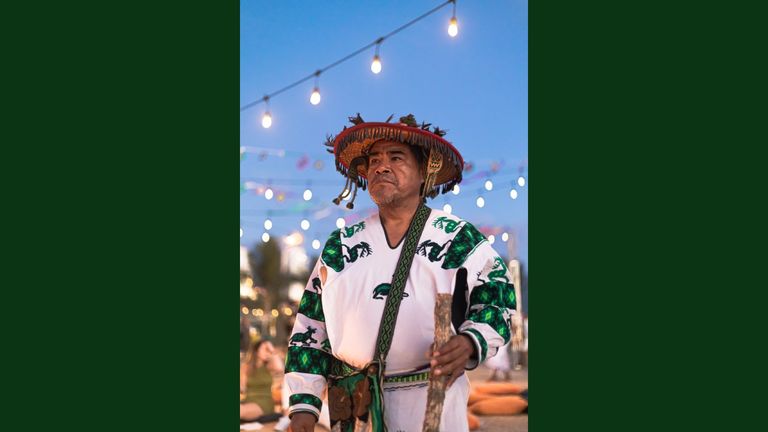On Aug. 9, the United Nations commemorates International Day of the World’s Indigenous Peoples, a time devoted to respect for Indigenous rights and cultures. And in Mexico, vibrant Indigenous peoples around the country offer memorable experiences — from annual events and festivals to solstice celebrations — to learn about and understand their cultures.
There are 68 indigenous groups living in Mexico, each with its own traditions, according to the International Work Group for Indigenous Affairs. So it’s no surprise that the events offered are especially diverse.
Here are just a few of the noteworthy ways to connect with Indigenous cultures in Mexico.
 Dia de los Muertos brings cultural events to numerous destinations within Mexico.
Dia de los Muertos brings cultural events to numerous destinations within Mexico.
Credit: 2024 Joanna/stock.adobe.comDia de Los Muertos (Day of the Dead)
One of Mexico’s most legendary annual events, the Day of the Dead offers a fascinating glimpse into how Indigenous and Catholic rituals have blended to create customs unique to Mexico.
The festivities typically take place from Oct. 28 to Nov. 2 every year, honoring the memory of deceased loved ones with colorful, handmade altars and personalized offerings. Some of the largest Day of the Dead events and ceremonies take place in Oaxaca, Michoacan, Mexico City, Yucatan and Chiapas.
“It might seem obvious, but Dia de los Muertos really is as big as you’ve heard, and it’s an extraordinary experience,” said Emmanuel Burgio, founder of Blue Parallel, a luxury tour operator that organizes customized itineraries in Mexico and other destinations. “Its popularity means it can get very busy, so it’s important you know where to go to experience it like a local, which is where working with a bespoke tour company such as Blue Parallel can really be instrumental.”
Other tour operators with Day of the Dead itineraries include Intrepid Travel, which offers a five-day excursion in Mexico City, and Journey Mexico, which has Day of the Dead trips in Chiapas, Mexico City, Oaxaca and San Miguel de Allende, as well as a 10-day “ultimate” itinerary that includes Mexico City, Morelia and San Miguel de Allende.
Another option for experiencing this emotionally moving holiday is Tia Stephanie Tours’ "Hanal Pixan: Food for the Souls” itinerary, which focuses on Day of the Dead observations in Yucatan. The trip includes visits to altar displays in the city of Merida, a cemetery in the town of Hoctun and the Mayan community of Teabo.
 An Indigenous community member at a ceremony at Puerto Vallarta's Velas Vallarta
An Indigenous community member at a ceremony at Puerto Vallarta's Velas Vallarta
Credit: 2024 Velas Resorts
Solstice and Equinox Celebrations
The solstice and equinox are two astronomical events — each of which takes place twice a year — that have long set the stage for ceremonies in Indigenous communities.
“The winter solstice is significant in Mayan culture, and there are often ceremonies and rituals performed by modern Mayan priests, celebrating the renewal of the solar cycle and invoking blessings for the coming year,” said Burgio of Blue Parallel.
He notes that Chichen Itza, one of the most famous archaeological sites in Mexico, hosts significant celebrations during the equinoxes and solstices, drawing thousands of visitors who come to witness the ancient Mayan astronomical and architectural marvels.
“These events can attract large crowds, but it’s a wonderful opportunity to immerse yourself in Mexican culture and learn about the astronomical significance and historical context of the events,” Burgio said. “Traditional Mayan dances, music and rituals are often performed, providing a rich cultural experience."
Travelers looking for a way to combine solstice and equinox celebrations with a luxury getaway, meanwhile, may want to consider Velas Vallarta in Puerto Vallarta. The property stages on-site ceremonies — the next are for the autumn equinox on Sept. 22, 2024, and the winter solstice on Dec. 21, 2024 — all led by members of the Huichol or Wixarika communities and dedicated to the elements of fire, water, earth and air.
 Cultural events and experiences take place in the neighboring towns of San Juan de Chamula and San Cristobal de las Casas in Chiapas.
Cultural events and experiences take place in the neighboring towns of San Juan de Chamula and San Cristobal de las Casas in Chiapas.
Credit: 2024 Alex Veka/Vibe AdventuresOther Indigenous Events around Mexico
Dia de los Muertos and solstice and equinox events may be among the nation’s highest-profile annual traditions, but there are an array of other festivals and events that can be equally interesting.
Among the most revered is Guelaguetza, a festival that takes place every July in Oaxaca. The event, which honors the goddess of corn, Centeotl, includes dance and music performances. It’s a wonderful opportunity to view the costumes and cultures of multiple communities, since it attracts participants from various Indigenous groups around the state of Oaxaca. Tia Stephanie Tours is among the operators offering guided trips to Oaxaca for this festival, with visits to various villages.
In Veracruz, meanwhile, the Xanath Festival is a lively celebration of the Totonac culture in the town of Papantla. Taking place in June, it features dance and music and is part of the larger Corpus Christi Festival. In Chiapas, Holy Week is an important time for the indigenous Mayan community in the town of San Juan Chamula, near the popular town of San Cristobal de las Casas. San Juan Chamula’s K'in-Jimultik (“new fire”) event, which takes place four days before Ash Wednesday, is a time of solemn religious ceremonies at the small main church, a venue with decor that reflects influences from both Catholic and Mayan religions. Vibe Adventures offers tours timed with the event, with departures from Mexico City.